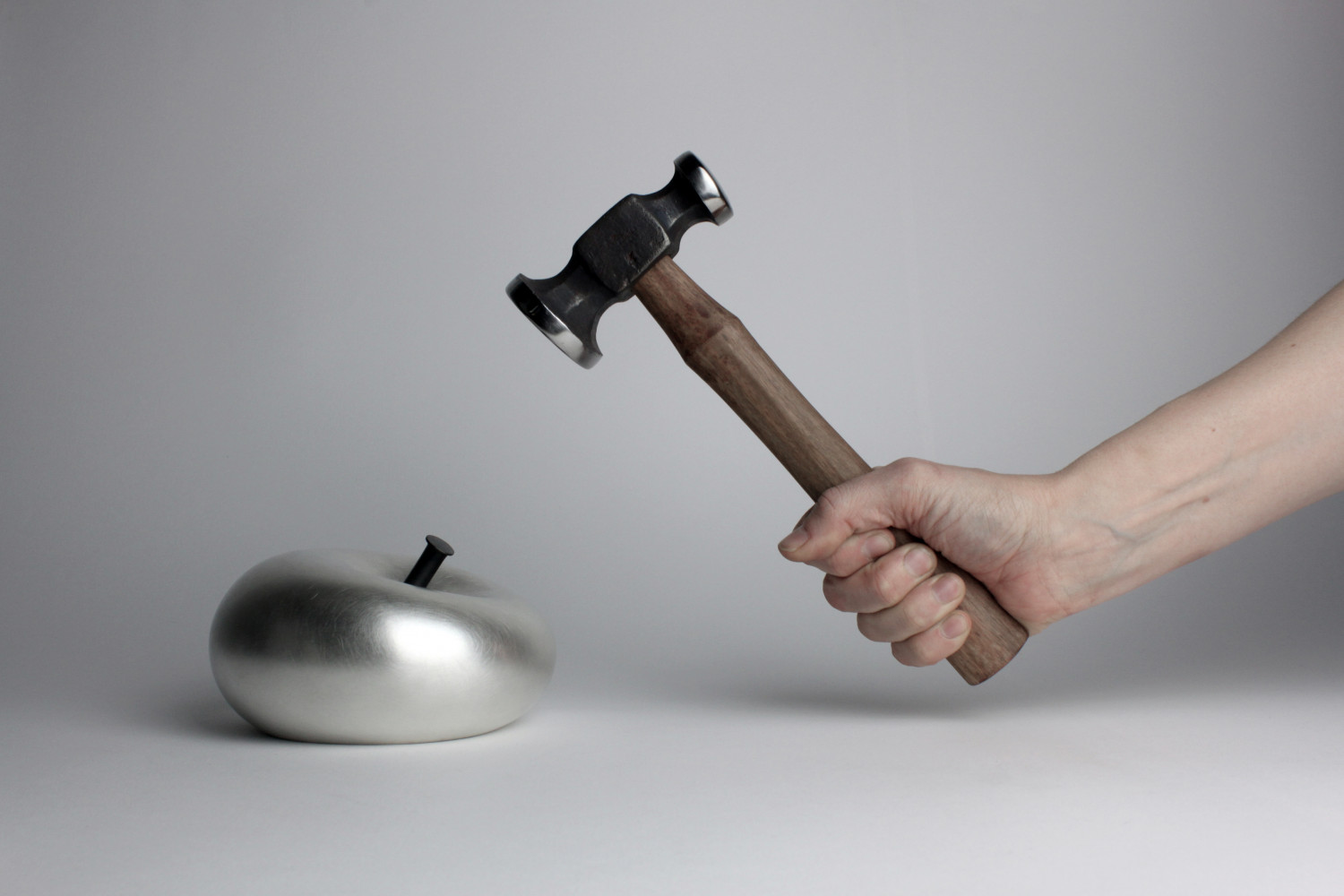Interview Gretal Ferguson
Though also trained in contemporary jewellery and object design, Gretal Fergusons practice is predominantly focused on contemporary silversmithing. She creates conceptual exhibition work using traditional craft skills in a sculptural setting, challenging the utilitarian traditions of her craft while honouring what came before. With the material process an integral part of her conceptual motivation, she embraces the arduous nature of silversmithing, using the hours of hammering to explore the work both aesthetically and conceptually, allowing it to unfold in a way it wouldn’t if the process was quick and less laborious.
This interview is a transcription of a conversation between Tom Iriks and Gretal Ferguson on October 6, 2022, via TEAMS.
First question: when and why did you decide to express yourself through silver?
Well, I came to silversmithing through jewellery. My sister dragged me to a silver jewellery course when I was pursuing a music degree. It was just a Saturday morning course at a high school, quite an abysmal setup. I think there was a pendant drill, pegs clamped onto a desk, and a hardware store torch. But I became pretty obsessed with it. A few years later, still obsessed, I decided to study jewellery and the course I enrolled in also covered object design. Fortunately for me, without much prior research, I was taught by these incredibly talented teachers, including a Norwegian master silversmith with around 50 years of experience. I didn't even know that silversmithing was a thing when I started. Then I did a project using shell forming, and I think that's when I truly fell in love with the freedom to create asymmetrical, non-utilitarian objects, and that's when my obsession with silversmithing began.
What do you find so magical about working with silver?
It's the movement, you know? Even when I teach it, a lot of the time, I find myself explaining raising, and I get to the point where I just say, "It's magic." The way you learn to manipulate the material is just mesmerizing. And you never truly master it. You're always learning more.
Can you talk about your creative process?
I often start with a concept rather than a specific physical piece in mind. I tend to brainstorm around a work a lot, sometimes even before I know what it's going to look like. I find that this way, the idea can inform the art and connect with the concept more effectively. In my work, a strong concept behind a piece often results in a more resolved outcome because there are justifications for the aesthetic choices I make. As for my process, I don't do much sketching because I'm not a great drawer, and I feel it dilutes what's in my head. I don't make mock-ups either, even though mentors have repeatedly told me I should because my forms are usually more fluid and bulbous, making them challenging to replicate on paper. Plus, I dislike working with clay. So, I generally dive straight into metalwork after attempting a few terrible linear drawings. I work more intuitively, often not knowing where I'm headed until the metal guides me.
Could you give some examples of concepts you've worked on?
I approach my work more artistically than traditionally, straddling the line between art and craft. Especially in Australia, where there isn't a strong tradition of silversmithing, I often find myself part of a community of artists rather than craftspeople. When I mention concepts, I'm essentially referring to the underlying idea behind the work. I don't just think about how I'm going to make something; I think about why I'm making it.
Can you elaborate on a series you've developed and the concept behind it? For example, the work you submitted for the 20th Silver Triennial?
Certainly, let's talk about that one. My recent series is titled "Nailed Down," and it reflects my growing concern over the gradual decline of my craft in Australia. This concern has significantly influenced my practice. The series delves into what happens when the intrinsic value of a material object surpasses the centuries-old tradition involved in crafting it. Throughout history, metalwork has often been melted down for new objects or treated as a commodity stored in bank vaults. This practice often leads to a disregard for the original craftsperson's skill and an overemphasis on the material itself. With fewer and fewer people carrying on these skills and traditions, we risk losing the craft entirely. These pieces are designed to resemble molten, pre-worked metal, but they are still laboriously shaped objects. I've intentionally left them without function, symbolizing the growing absence of skills needed to work with metal. Each piece is "nailed down" as an attempt to preserve these traditions and craft skills from slipping away completely.
So, are you suggesting that silver's value is more driven by its monetary worth rather than its artistic value?
It's a bit different in my country compared to Europe. We don't have the same tradition here. When I tell people I'm a silversmith, they often have no idea what it means. They might say, "Oh, my sister-in-law makes silver jewellery and sells it on Etsy," but it's not quite the same. Silversmithing is an ancient craft, but it lacks a strong tradition here. I studied in Birmingham, where the school was older than my government. How can we have the same traditions here? But there's a growing community of metalworkers in Australia, albeit they're often referred to as metalsmiths rather than specifically silver smiths.
But there is a community of metal smiths in Australia, right? I've spoken to some other people in Sydney who mentioned that.
Yes, there is a community, but it's not as well-supported as in the UK and other parts of Europe, where institutions assist with obtaining silver. People often question why I call myself a silversmith when I work with copper. It's more wishful thinking, really. Australia's vast size makes it challenging to be part of a community. It could involve a 16-hour drive just to connect with others. For instance, I recently returned from Sydney, and the journey took me two days. It's quite different from the UK, where there are people and events everywhere.
Returning to your work, you sometimes create pieces that are more or less usable or appear to have a utilitarian purpose. Is that correct?
I don't typically create functional objects. I've attempted to make functional items in the past, but they usually end up as installations or wall pieces rather than functional pieces. I lean more towards object-based work, which tends to be less utilitarian.
Do you think about your audience or where your objects should ultimately be displayed when you're working on a new piece?
I try not to think too much about my audience when creating. If you make art solely for others, you might dismiss many of your ideas because you're thinking about what someone else would want. This can stifle some of the best ideas. If everyone creates with a specific audience in mind, you risk producing very similar and derivative work.
Do you think about the ideal installation setting for your objects? Do you consider museums, galleries, collectors, or other contexts?
I consider all of the above. It can vary from series to series, as my work can be aesthetically different from one series to the next. I embrace a more conceptual approach, so it depends on the theme and audience for each specific body of work.
Let's discuss the role of technique. How important is it in your creative process? Does it work with you or against you?
Technique is essential in my work, like in any craft. However, my approach is somewhat different due to the limited tradition and industry support for silversmithing in Australia. I'm more isolated in that sense. My technique often leans towards a DIY approach. While I received traditional training initially, I've had to figure things out on my own since I finished studying. My technique essentially involves getting the metal to behave the way I want it to. I draw from various crafts like panel beating and instrument repair, essentially anything that involves working with metal. Not having a strong tradition of silversmithing here makes it easier for me to improvise because there's no one telling me that I'm doing it wrong. I've had people on social media critique my choice of tools, but they often have fully equipped workshops accumulated over centuries, while I'm making the same shapes using basic tools. So, my technique is crucial, but it involves constant improvisation based on what I have available. This is likely why I tend to be a more intuitive maker, I suppose.
In your opinion, what is the difference between a designer and someone who creates with their own hands?
I mean, I think like when I originally studied, I would have to design and, you know, have the renders, measurements, and all that, and then make that piece exactly like that. For me, I just don't work that way anymore. I would prefer to just see where we go, see where we end up. And yeah, I think it's that kind of eternal question really, isn't it? Sort of like, you know, design versus craft, arts versus crafts. I think if you're making it, you're going to have a better idea of what's possible than someone who's designing something without that material knowledge. I think you have a better scope of what's attainable.
You told me you start with a concept. Does the concept follow the form or does the form follow the concept. How does that work for you?
Both. I've had days where I'll wake up with a fully formed concept. I know exactly what the work's going to look like. I know how I'm going to photograph it, and then, you know. And you're like, "Sweet. Let's go." And then other times, I'll have work in my head or a series that I really want to make, but I don't know what it's going to look like. I know the concept. I know the sort of techniques for the finishing. I'm going to do the material, but I can't figure out what the shape's going to be yet. But I already know, yeah, the finish, the texture, the patination, all that sort of stuff. But I just don't know how it's gonna look best. So that's just been ruminating for about a year. We really need to get on that and like figure that one out because that's kind of the next one I'm thinking of.
Do you want to make a statement with your work?
I guess so, yeah. Yeah, probably, definitely would be the answer. Yeah, like I've said, silversmithing in Australia is not as big as I'd like it to be. I think trying to educate people almost about what it is like. I've just basically done a whole show, sort of the disappearance of it, and I think a lot of people, once I sort of explain the concept to them, do kind of get more of an idea of how easy it is for it to disappear. You know, if we don't have that new generation of people and apprentices and stuff like that, which I think is a problem in most countries. But yeah, just trying to, almost trying to raise awareness essentially.
That's it!
Yes, alright, cool.


